What You Didn’t Know About Scott Kelly And Living In Space (Floating Urine Is Involved)
What You Didn’t Know About Scott Kelly and Living in Space (Floating Urine is Involved)
First Ever NASA Reddit AMA from Space Recap

NASA astronaut Scott Kelly hosted a Reddit Ask Me Anything on Jan. 23 where people, well, asked him anything.
Kelly answered a range of questions from whether the crew members play space pranks on one another ("Occasionally…" Kelly said without elaboration.) to whether Kelly's recovery plan will be different than normal ("I think my rehab plan is the same as if I were here for 6 months, but I'm not positive.").
To start off, here are a few quick facts we learned about Kelly during the AMA:
The advice he would've given himself before going into space on day 1 would be to pack lighter.
His favorite David Bowie song is "Modern Love," and his favorite non-space related movie is "The Godfather."
He uses a Nikon D4 when taking pictures (camera settings and lenses vary).
He thought it was cool to watch the movie "Gravity" while he was on the space station, because that's where the movie took place.
Once he lands, Kelly will miss the challenge of being aboard the space station the most.
Here are a few fun questions that astronaut Scott Kelly answered:
What’s the creepiest thing you’ve encountered while on the job?

Could a rogue spaceship sneak up on the space station?

We finally got an answer for one thing so many of you have been curious about…why does Scott Kelly always fold his arms?


When astronauts go up to space, they experience something very few others have and see Earth from a very unique perspective. What’s one thing Kelly will do differently once he returns home?

Kelly also told one user something unusual about being in space that people normally don’t think about: feet calluses.

Another user wanted to know what the largest societal misconception about space/space travel is. According to Kelly, it has nothing to do with science.



To read the entire Reddit AMA with Kelly, visit his IAmA thread.
Kelly's #YearInSpace ends Mar. 2. Follow him until the end of the journey (and beyond) on Twitter, Instagram and Facebook.
Make sure to follow us on Tumblr for your regular dose of space: http://nasa.tumblr.com
More Posts from Nasa and Others
Caution: Universe Work Ahead 🚧
We only have one universe. That’s usually plenty – it’s pretty big after all! But there are some things scientists can’t do with our real universe that they can do if they build new ones using computers.
The universes they create aren’t real, but they’re important tools to help us understand the cosmos. Two teams of scientists recently created a couple of these simulations to help us learn how our Nancy Grace Roman Space Telescope sets out to unveil the universe’s distant past and give us a glimpse of possible futures.
Caution: you are now entering a cosmic construction zone (no hard hat required)!

This simulated Roman deep field image, containing hundreds of thousands of galaxies, represents just 1.3 percent of the synthetic survey, which is itself just one percent of Roman's planned survey. The full simulation is available here. The galaxies are color coded – redder ones are farther away, and whiter ones are nearer. The simulation showcases Roman’s power to conduct large, deep surveys and study the universe statistically in ways that aren’t possible with current telescopes.
One Roman simulation is helping scientists plan how to study cosmic evolution by teaming up with other telescopes, like the Vera C. Rubin Observatory. It’s based on galaxy and dark matter models combined with real data from other telescopes. It envisions a big patch of the sky Roman will survey when it launches by 2027. Scientists are exploring the simulation to make observation plans so Roman will help us learn as much as possible. It’s a sneak peek at what we could figure out about how and why our universe has changed dramatically across cosmic epochs.
This video begins by showing the most distant galaxies in the simulated deep field image in red. As it zooms out, layers of nearer (yellow and white) galaxies are added to the frame. By studying different cosmic epochs, Roman will be able to trace the universe's expansion history, study how galaxies developed over time, and much more.
As part of the real future survey, Roman will study the structure and evolution of the universe, map dark matter – an invisible substance detectable only by seeing its gravitational effects on visible matter – and discern between the leading theories that attempt to explain why the expansion of the universe is speeding up. It will do it by traveling back in time…well, sort of.
Seeing into the past
Looking way out into space is kind of like using a time machine. That’s because the light emitted by distant galaxies takes longer to reach us than light from ones that are nearby. When we look at farther galaxies, we see the universe as it was when their light was emitted. That can help us see billions of years into the past. Comparing what the universe was like at different ages will help astronomers piece together the way it has transformed over time.

This animation shows the type of science that astronomers will be able to do with future Roman deep field observations. The gravity of intervening galaxy clusters and dark matter can lens the light from farther objects, warping their appearance as shown in the animation. By studying the distorted light, astronomers can study elusive dark matter, which can only be measured indirectly through its gravitational effects on visible matter. As a bonus, this lensing also makes it easier to see the most distant galaxies whose light they magnify.
The simulation demonstrates how Roman will see even farther back in time thanks to natural magnifying glasses in space. Huge clusters of galaxies are so massive that they warp the fabric of space-time, kind of like how a bowling ball creates a well when placed on a trampoline. When light from more distant galaxies passes close to a galaxy cluster, it follows the curved space-time and bends around the cluster. That lenses the light, producing brighter, distorted images of the farther galaxies.
Roman will be sensitive enough to use this phenomenon to see how even small masses, like clumps of dark matter, warp the appearance of distant galaxies. That will help narrow down the candidates for what dark matter could be made of.

In this simulated view of the deep cosmos, each dot represents a galaxy. The three small squares show Hubble's field of view, and each reveals a different region of the synthetic universe. Roman will be able to quickly survey an area as large as the whole zoomed-out image, which will give us a glimpse of the universe’s largest structures.
Constructing the cosmos over billions of years
A separate simulation shows what Roman might expect to see across more than 10 billion years of cosmic history. It’s based on a galaxy formation model that represents our current understanding of how the universe works. That means that Roman can put that model to the test when it delivers real observations, since astronomers can compare what they expected to see with what’s really out there.

In this side view of the simulated universe, each dot represents a galaxy whose size and brightness corresponds to its mass. Slices from different epochs illustrate how Roman will be able to view the universe across cosmic history. Astronomers will use such observations to piece together how cosmic evolution led to the web-like structure we see today.
This simulation also shows how Roman will help us learn how extremely large structures in the cosmos were constructed over time. For hundreds of millions of years after the universe was born, it was filled with a sea of charged particles that was almost completely uniform. Today, billions of years later, there are galaxies and galaxy clusters glowing in clumps along invisible threads of dark matter that extend hundreds of millions of light-years. Vast “cosmic voids” are found in between all the shining strands.
Astronomers have connected some of the dots between the universe’s early days and today, but it’s been difficult to see the big picture. Roman’s broad view of space will help us quickly see the universe’s web-like structure for the first time. That’s something that would take Hubble or Webb decades to do! Scientists will also use Roman to view different slices of the universe and piece together all the snapshots in time. We’re looking forward to learning how the cosmos grew and developed to its present state and finding clues about its ultimate fate.

This image, containing millions of simulated galaxies strewn across space and time, shows the areas Hubble (white) and Roman (yellow) can capture in a single snapshot. It would take Hubble about 85 years to map the entire region shown in the image at the same depth, but Roman could do it in just 63 days. Roman’s larger view and fast survey speeds will unveil the evolving universe in ways that have never been possible before.
Roman will explore the cosmos as no telescope ever has before, combining a panoramic view of the universe with a vantage point in space. Each picture it sends back will let us see areas that are at least a hundred times larger than our Hubble or James Webb space telescopes can see at one time. Astronomers will study them to learn more about how galaxies were constructed, dark matter, and much more.
The simulations are much more than just pretty pictures – they’re important stepping stones that forecast what we can expect to see with Roman. We’ve never had a view like Roman’s before, so having a preview helps make sure we can make the most of this incredible mission when it launches.
Learn more about the exciting science this mission will investigate on Twitter and Facebook.
Make sure to follow us on Tumblr for your regular dose of space!

This unprocessed image shows features in Saturn's atmosphere from closer than ever before. The view was captured by our Cassini spacecraft during its first Grand Finale dive between the planet and its rings on April 26, 2017.
As Cassini dove through the gap, it came within about 1,900 miles (3,000 kilometers) of Saturn's cloud tops (where the air pressure is 1 bar -- comparable to the atmospheric pressure of Earth at sea level) and within about 200 miles (300 kilometers) of the innermost visible edge of the rings.
See all the unprocessed images from Cassini: https://saturn.jpl.nasa.gov/galleries/raw-images/
Make sure to follow us on Tumblr for your regular dose of space: http://nasa.tumblr.com
Solar System: 5 Things To Know This Week
We live during one of the great eras of exploration. At this very moment, there are dozens of spacecraft surveying the solar system, from Mars, to Saturn, to Pluto and beyond. What’s more, you can ride along with these expeditions — all you need is an internet connection to see the latest discoveries from deep space. Here are a few essential resources for the armchair astronaut:
1. It’s Like Facebook, but for Planets

Or is it more of a Hitchhiker’s Guide to the Solar System? Whatever you want to call it, our Planets page offers quick rundowns, as well as in-depth guides, for all the major bodies in the solar system. Explore from the sun all they way out to the Oort Cloud.
2. Robots to the Rescue

Saturn looks spectacular through a telescope, but there’s only so much you can learn about it from the ground. Going there in person is tough, too. While we are now preparing to send astronauts beyond Earth orbit, a human mission to Saturn won’t be possible in the near future. That’s where the space robots come in. For example, the Cassini spacecraft studies Saturn and its moons up close, sometimes even doing things like flying right through the geyser plumes of the ice moon Enceladus. See all the solar system missions, past and present, where they went and what they’ve seen HERE.
3. Keep Your Eyes on This One

If you still haven’t tried Eyes on the Solar System, you’re missing out. This online simulation lets you tour the planets and track the past, current and future positions of spacecraft — right in your web browser, all in 3D. Eyes on the Solar System uses real NASA data to help you take a virtual flight across both space and time.
4. Images in the Raw

You don’t have to wait for a news release to see pictures from planetary missions. Some missions allow you to see raw, unprocessed images sent straight from the spacecraft. What these images lack in explanatory captions they make up for in freshness — sometimes you can see pictures from Mars or Saturn that are mere hours old. There’s something exhilarating about being among the first human beings ever to see an alien landscape. Peruse our new raw image pages HERE.
5. Bring It On Home

After you’ve toured the far reaches of the solar system, you can always come home again. When you have spent time studying the harsh conditions of our neighboring planets, the charms of a unique paradise come into sharp focus, the place we call Earth. Watch a real-time video feed from Earth orbit HERE. You can also see a daily global view of our planet from a million miles away HERE. Download THIS Earth Now mobile app to hold the planet in your hands.
Want to learn more? Read our full list of the 10 things to know this week about the solar system HERE.
Make sure to follow us on Tumblr for your regular dose of space: http://nasa.tumblr.com
Ocean Worlds Beyond Earth
We’re incredibly lucky to live on a planet drenched in water, nestled in a perfect distance from our sun and wrapped with magnetic fields keeping our atmosphere intact against harsh radiation and space weather.

We know from recent research that life can persist in the cruelest of environments here on Earth, which gives us hope to finding life thriving on other worlds. While we have yet to find life outside of Earth, we are optimistic about the possibilities, especially on other ocean worlds right here in our solar system.
So…What’s the News?!
Two of our veteran missions are providing tantalizing new details about icy, ocean-bearing moons of Jupiter and Saturn, further enhancing the scientific interest of these and other “ocean worlds” in our solar system and beyond!
Cassini scientists announce that a form of energy for life appears to exist in Saturn’s moon Enceladus, and Hubble researchers report additional evidence of plumes erupting from Jupiter’s moon Europa.
The Two Missions: Cassini and Hubble
Cassini
Our Cassini spacecraft has found that hydrothermal vents in the ocean of Saturn’s icy moon Enceladus are producing hydrogen gas, which could potentially provide a chemical energy source for life.

Cassini discovered that this little moon of Saturn was active in 2005. The discovery that Enceladus has jets of gas and icy particles coming out of its south polar region surprised the world. Later we determined that plumes of material are coming from a global ocean under the icy crust, through large cracks known as “tiger stripes.”

We have more evidence now – this time sampled straight from the plume itself – of hydrothermal activity, and we now know the water is chemically interacting with the rock beneath the ocean and producing the kind of chemistry that could be used by microbes IF they happened to be there.

This is the culmination of 12 years of investigations by Cassini and a capstone finding for the mission. We now know Enceladus has nearly all the ingredients needed for life as we know it.

The Cassini spacecraft made its deepest dive through the plume on Oct. 28, 2015. From previous flybys, Cassini determined that nearly 98% of the gas in the plume is water and the rest is a mixture of other molecules, including carbon dioxide, methane and ammonia.

Cassini’s other instruments provided evidence of hydrothermal activity in the ocean. What we really wanted to know was…Is there hydrogen being produced that microbes could use to make energy? And that’s exactly what we found!

To be clear…we haven’t discovered microbes at Enceladus, but vents of this type at Earth host these kinds of life. We’re cautiously excited at the prospect that there might be something like this at Enceladus too!
Hubble
The Hubble Space Telescope has also been studying another ocean world in our solar system: Europa!

Europa is one of the four major moons of Jupiter, about the size of our own moon but very different in appearance. It’s a cold, icy world with a relatively smooth, bright surface crisscrossed with dark cracks and patches of reddish material.

What makes Europa interesting is that it’s believed to have a global ocean, underneath a thick crust of ice. In fact, it’s got about twice as much ocean as planet Earth!

In 2014, we detected evidence of intermittent water plumes on the surface of Europa, which is interesting because they may provide us with easier access to subsurface liquid water without having to drill through miles of ice.

And now, in 2016, we’ve found one particular plume candidate that appears to be at the same location that it was seen in 2014.
This is exciting because if we can establish that a particular feature does repeat, then it is much more likely to be real and we can attempt to study and understand the processes that cause it to turn on or off.

This plume also happens to coincide with an area where Europa is unusually warm as compared to the surrounding terrain. The plume candidates are about 30 to 60 miles (50 to 100 kilometers) in height and are well-positioned for observation, being in a relatively equatorial and well-determined location.
What Does All This Mean and What’s Next?
Hubble and Cassini are inherently different missions, but their complementary scientific discoveries, along with the synergy between our current and planned missions, will help us in finding out whether we are alone in the universe.
Hubble will continue to observe Europa. If you’re wondering how we might be able to get more information on the Europa plume, the upcoming Europa Clipper mission will be carrying a suite of 9 instruments to investigate whether the mysterious icy moon could harbor conditions favorable for life. Europa Clipper is slated to launch in the 2020s.

This future mission will be able to study the surface of Europa in great detail and assess the habitability of this moon. Whether there’s life there or not is a question for this future mission to discover!
Make sure to follow us on Tumblr for your regular dose of space: http://nasa.tumblr.com
Here’s What You Need to Know About Near-Earth Objects
Our solar system is littered with asteroids and comets, and sometimes they get a little close to Earth. But no need to worry! This happens all the time. When an asteroid or comet could come close to our planet, it’s known as a near-Earth object – aka NEO.
But how close is “close”?

A near-Earth object is defined as an object that could pass by our Earth within 30 million miles. We begin to keep close watch on objects that could pass within 5 million miles of our planet.

To put that into perspective, our Moon is only 238,900 miles away.
However unlikely an impact is, we want to know about all near-Earth objects. Our Planetary Defense Coordination Office maintains watch for asteroids and comets coming close to Earth. Along with our partners, we discover, catalog and characterize these bodies.

But what if one of these objects posed a threat?
We want to be prepared. That is why we are working on several deflection techniques and technologies to help protect our planet.

So next time that you hear of an asteroid passing “close” to Earth, know that it’s just one of many that we are tracking.

Here are 10 more things you should know about Planetary Defense.
Make sure to follow us on Tumblr for your regular dose of space: http://nasa.tumblr.com
What’s Up for April 2016?
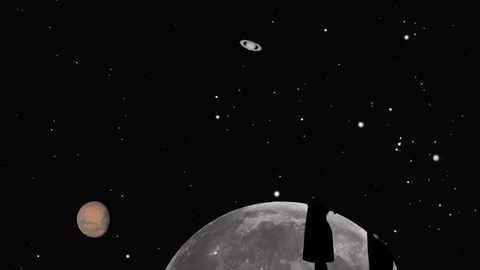
Jupiter, Mars, the Lyrid meteor shower and 2016’s best views of Mercury are all visible in the sky this month.
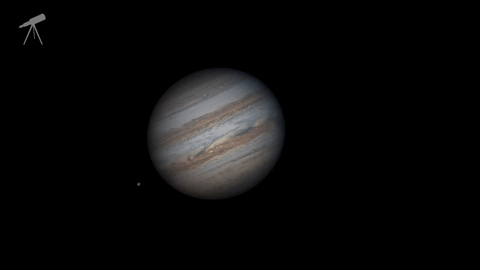
Jupiter, where our Juno mission will begin orbiting on July 4, continues to shine almost as brightly this month as last. And eagle-eyed telescope viewers will see a transit, a shadow transit, an occultation and an eclipse of Jupiter’s moons- all in one night: April 6-7.
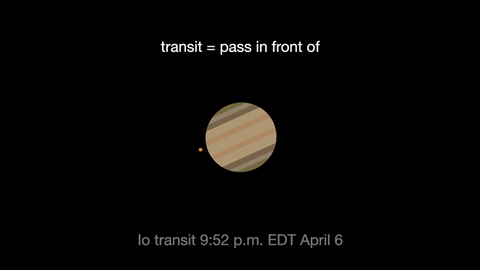
Io transits first, crossing the planet beginning at 9:52 p.m. EDT. It’s shadow can be seen less than an hour later.
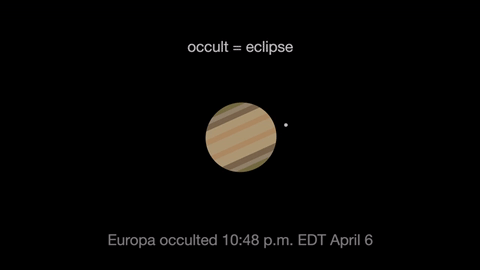
Next Jupiter occults, or eclipses, Europa as Europa slips behind the giant planet at 10:48 p.m. EDT. At 3 a.m. Europa reappears from its eclipse, dramatically leaving the shadow of Jupiter.
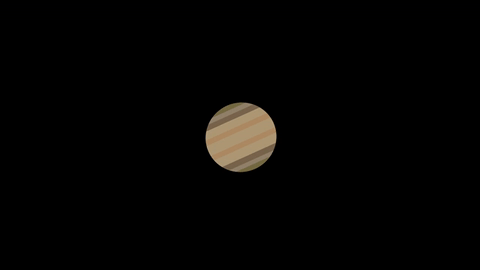
Ganymede transits the planet beginning at 1:01 EDT April 7.
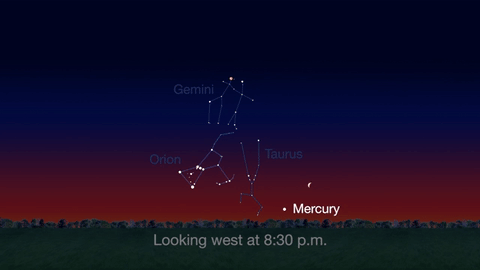
Check out the other planets in April, too! Mercury is always a challenging object to view, but this month you can spot it after sunset about 10 degrees above the horizon. Through a telescope you can see its phase. It will appear like a tiny crescent moon, with about 1/3 of its disk illuminated.
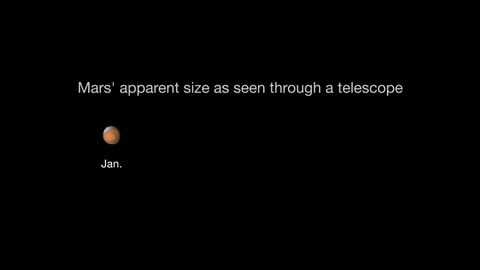
Mars is finally visible before midnight this month. It rises in the southeast at about 10 p.m. by the end of April. The best observing of Mars will be when it is highest in the sky. This means a few hours before dawn. Its brightness and apparent size increase dramatically this month. By month’s end, Mars appears nearly twice as bright as at the beginning of the month.
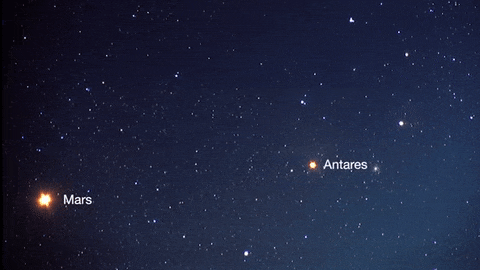
About mid-month you’ll see Mars near its rival in the sky: the similar-colored red supergiant star Antares. The name “Antares” means “equal to or rival of Mars”.
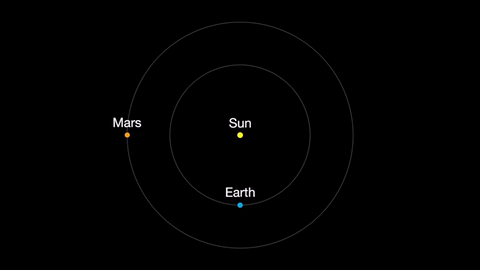
Earth moves almost twice as fast as Mars does, so it often passes Mars in their race around the sun. This causes “retrograde motion”: an illusion we see from our viewpoint on Earth.
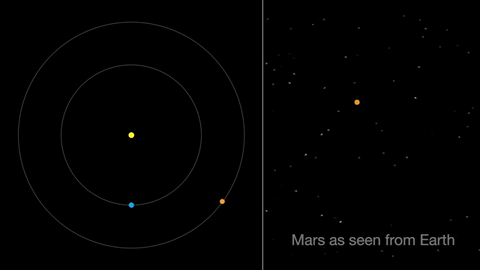
Retrograde motion happens as Earth catches up to Mars, causing Mars to appear slow to slow its eastward motion against the stars. After a few days, when Earth has overtaken Mars, the Red Planet seems to move westward. Eventually, Earth moves far enough around its orbit that Mars appears to be moving eastward again.
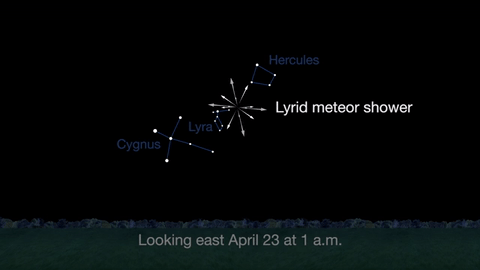
April features one meteor shower, the Lyrids. This year the Lyrids are marred by the full moon. The best time to view will be just before dawn on April 23, when the constellation Lyra is overhead and the moon will be near to setting.
With all of these great things to spot in the sky this month, be sure to get outside and look up!
Make sure to follow us on Tumblr for your regular dose of space: http://nasa.tumblr.com
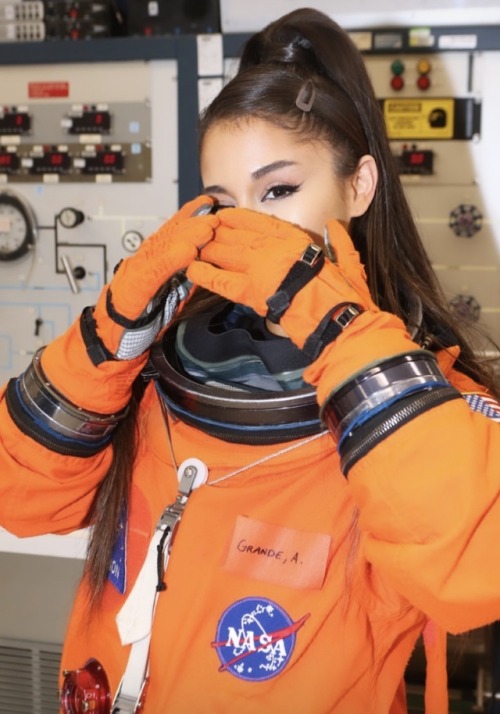
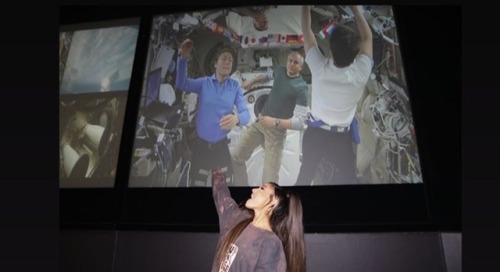
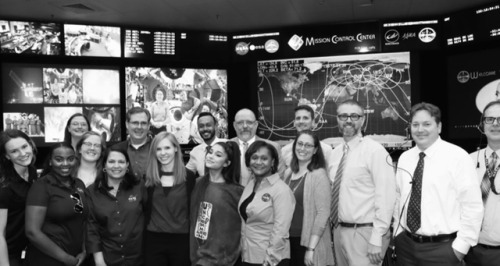

Ariana Grande got some space at N-A-S-A. Get yours too.
Make sure to follow us on Tumblr for your regular dose of space: http://nasa.tumblr.com.
10 Space & Football Facts You Probably Didn’t Know
There are more connections between space and football than you may have originally thought. Here are a few examples of how...
1. The International Space Station and a football field are basically the same size

Yes, that’s right! The International Space Station measures 357 feet end-to-end. That’s almost equivalent to the length of a football field including the end zones (360 feet).
2. It would take over 4,000 footballs to fill the Orion spacecraft

Our Orion spacecraft is being designed to carry astronauts to deep space destinations, like Mars! It will launch atop the most powerful rocket ever built, the Space Launch System rocket. If you were to fill the Orion spacecraft with footballs instead of crew members, you would fit a total of 4,625!
3. Our new Space Launch System rocket is taller than a football field is long

We’re building the most powerful rocket ever, the Space Launch System. At its full height it will stand 384 feet – 24 feet taller than a football field is long.
4. The crew living on space station will see the day begin and end…twice…during the Super Bowl

An average NFL game lasts more than three hours. Traveling at 17,500 mph, the crew on the space station will see two sunrises and two sunsets in that time…they see 16 sunrises and sunsets each day!
5. Playing football on Mars would be…lighter

On Mars, a football would weigh less than half a pound, while a 200-pund football player would weigh just about 75 pounds.
6. It would take over 3,000 hours for a football to reach the Moon

Talk about going long…if you threw a football to the Moon at 60 mph, the average speed of an NFL pass, it would take 3,982 hours, or 166 days, to get there. The quickest trip to the Moon was the New Horizons probe, which zipped pass the Moon in just 8 hours 35 minutes on its way to Pluto
7. The longest field goal kick in history would’ve been WAY easier to make on Mars

The longest field goal kick in NFL history is 64 yards. On Mars, at 1/3 the gravity of Earth, that same field goal, ignoring air resistance, could have been made from almost two football fields away (192 yards).
8. A quarterback would be able to throw even further on Mars

Aerodynamic drag doesn’t happen on Mars. With a very thin atmosphere and low gravity to drag the ball down, a quarterback could throw the football three times as far as he could on Earth. A receiver would have to be much further down the field to catch the throw
9. Football players and astronauts both need to exercise every day

Football players must be quick and powerful, honing the physical skills necessary for their unique positions. In space, maintaining physical fitness is a top priority, since astronauts will lose bone and muscle mass if they do not keep up their strength and conditioning.
10. Clear team communication is important on the football field AND in space

During football games, calling plays and relaying information from coaches on the sidelines or in the booth to players on the field is essential. Coaches communicate directly with quarterbacks and a defensive player between plays via radio frequencies. They must have a secure and reliable system that keeps their competitors from listening in and also keeps loud fan excitement from drowning out what can be heard. Likewise, reliable communication with astronauts in space and robotic spacecraft exploring far into the solar system is key to our mission success.
A radio and satellite communications network allows space station crew members to talk to the ground-based team at control centers, and for those centers to send commands to the orbital complex.
Make sure to follow us on Tumblr for your regular dose of space: http://nasa.tumblr.com
What's your opinion on astronaut food?
A Total Solar Eclipse Revealed Solar Storms 100 Years Before Satellites
Just days from now, on Aug. 21, 2017, the Moon will pass between the Sun and Earth, casting its shadow down on Earth and giving all of North America the chance to see a solar eclipse. Remember that it is never safe to look at the partially eclipsed or uneclipsed Sun, so make sure you use a solar filter or indirect viewing method if you plan to watch the eclipse.

Eclipses set the stage for historic science. Past eclipses enabled scientists to study the Sun’s structure, find the first proof of Einstein’s theory of general relativity, and discover the element helium — 30 years before it was found on Earth..
We’re taking advantage of the Aug. 21 eclipse by funding 11 ground-based scientific studies. As our scientists prepare their experiments for next week, we’re looking back to an historic 1860 total solar eclipse, which many think gave humanity our first glimpse of solar storms — called coronal mass ejections — 100 years before scientists first understood what they were.

Coronal mass ejections, or CMEs, are massive eruptions made up of hot gas, plasma and magnetic fields. Bursting from the Sun’s surface, these giant clouds of solar material speed into space up to a million miles per hour and carry enough energy to power the world for 10,000 years if we could harness it. Sometimes, when they’re directed towards Earth, CMEs can affect Earth’s space environment, creating space weather: including triggering auroras, affecting satellites, and – in extreme cases – even straining power grids.

Scientists observed these eruptions in the 1970s during the beginning of the modern satellite era, when satellites in space were able to capture thousands of images of solar activity that had never been seen before.

But in hindsight, scientists realized their satellite images might not be the first record of these solar storms. Hand-drawn records of an 1860 total solar eclipse bore surprising resemblance to these groundbreaking satellite images.
On July 18, 1860, the Moon’s shadow swept across North America, Spain and North Africa. Because it passed over so much populated land, this eclipse was particularly well-observed, resulting in a wealth of scientific observations.

Drawings from across the path of the 1860 eclipse show large, white finger-like projections in the Sun’s atmosphere—called the corona—as well as a distinctive, bubble-shaped structure. But the observations weren’t uniform – only about two-thirds of the 1860 eclipse sketches showed this bubble, setting off heated debate about what this feature could have been.

Sketches from the total solar eclipse of July 1860.
One hundred years later, with the onset of space-based satellite imagery, scientists got another piece of the puzzle. Those illustrations from the 1860 eclipse looked very similar to satellite imagery showing CMEs – meaning 1860 may have been humanity’s first glimpse at these solar storms, even though we didn’t understand what we were seeing.

While satellites provide most of the data for CME research, total solar eclipses seen from the ground still play an important role in understanding our star. During an eclipse, observers on the ground are treated to unique views of the innermost corona, the region of the solar atmosphere that triggers CMEs.
This region of the Sun’s atmosphere can’t be measured at any other time, since human-made instruments that create artificial eclipses must block out much of the Sun’s atmosphere—as well as its bright face—in order to produce clear images. Yet scientists think this important region is responsible for accelerating CMEs, as well as heating the entire corona to extraordinarily high temperatures.

When the path of an eclipse falls on land, scientists take advantage of these rare chances to collect unique data. With each new total solar eclipse, there’s the possibility of new information and research—and maybe, the chance to reveal something as astronomical as the first solar storm.

Learn all about the Aug. 21 eclipse at eclipse2017.nasa.gov, and follow @NASASun on Twitter and NASA Sun Science on Facebook for more. Watch the eclipse through the eyes of NASA at nasa.gov/eclipselive starting at 12 PM ET on Aug. 21.
Make sure to follow us on Tumblr for your regular dose of space: http://nasa.tumblr.com
-
 gojos-gurl-01 liked this · 2 years ago
gojos-gurl-01 liked this · 2 years ago -
 yanchiswrittenvoice reblogged this · 3 years ago
yanchiswrittenvoice reblogged this · 3 years ago -
 yanchiswrittenvoice liked this · 3 years ago
yanchiswrittenvoice liked this · 3 years ago -
 colly-flower reblogged this · 5 years ago
colly-flower reblogged this · 5 years ago -
 colly-flower liked this · 5 years ago
colly-flower liked this · 5 years ago -
 jakepalooka liked this · 5 years ago
jakepalooka liked this · 5 years ago -
 rogue-wonderful reblogged this · 5 years ago
rogue-wonderful reblogged this · 5 years ago -
 rogue-wonderful liked this · 5 years ago
rogue-wonderful liked this · 5 years ago -
 smarth4 liked this · 5 years ago
smarth4 liked this · 5 years ago -
 alchemicalapocalypse liked this · 5 years ago
alchemicalapocalypse liked this · 5 years ago -
 stjimmy72 reblogged this · 5 years ago
stjimmy72 reblogged this · 5 years ago -
 moxie-filled-strumpet liked this · 5 years ago
moxie-filled-strumpet liked this · 5 years ago -
 madmak1 reblogged this · 5 years ago
madmak1 reblogged this · 5 years ago -
 clankit liked this · 5 years ago
clankit liked this · 5 years ago -
 mercurial-space-case reblogged this · 5 years ago
mercurial-space-case reblogged this · 5 years ago -
 mercurial-space-case liked this · 5 years ago
mercurial-space-case liked this · 5 years ago -
 silver-tongued-randomness liked this · 5 years ago
silver-tongued-randomness liked this · 5 years ago -
 fuckyeahcelestialthings reblogged this · 5 years ago
fuckyeahcelestialthings reblogged this · 5 years ago -
 emilyshka liked this · 5 years ago
emilyshka liked this · 5 years ago -
 zeeseventeen liked this · 5 years ago
zeeseventeen liked this · 5 years ago -
 delta-leader-lukas-propagan-blog liked this · 5 years ago
delta-leader-lukas-propagan-blog liked this · 5 years ago -
 michelle-ish liked this · 5 years ago
michelle-ish liked this · 5 years ago -
 princely-affairs reblogged this · 5 years ago
princely-affairs reblogged this · 5 years ago -
 princely-affairs liked this · 5 years ago
princely-affairs liked this · 5 years ago -
 ejnuyc reblogged this · 6 years ago
ejnuyc reblogged this · 6 years ago -
 ejnuyc liked this · 6 years ago
ejnuyc liked this · 6 years ago -
 cicadis-blog liked this · 6 years ago
cicadis-blog liked this · 6 years ago -
 hydro-dragon liked this · 7 years ago
hydro-dragon liked this · 7 years ago -
 hecatesg liked this · 7 years ago
hecatesg liked this · 7 years ago -
 sidereon-spaceace liked this · 7 years ago
sidereon-spaceace liked this · 7 years ago -
 invalidincorrect liked this · 7 years ago
invalidincorrect liked this · 7 years ago -
 harbringerofdoom liked this · 7 years ago
harbringerofdoom liked this · 7 years ago -
 thunder-the-ranger-wolf reblogged this · 7 years ago
thunder-the-ranger-wolf reblogged this · 7 years ago -
 herbinglicious liked this · 7 years ago
herbinglicious liked this · 7 years ago -
 segalia liked this · 7 years ago
segalia liked this · 7 years ago -
 hikihachiman liked this · 7 years ago
hikihachiman liked this · 7 years ago -
 fabricandcircuits reblogged this · 7 years ago
fabricandcircuits reblogged this · 7 years ago -
 viduatenebrarum reblogged this · 7 years ago
viduatenebrarum reblogged this · 7 years ago -
 martingore101 liked this · 7 years ago
martingore101 liked this · 7 years ago -
 curlyfreshi liked this · 7 years ago
curlyfreshi liked this · 7 years ago
Explore the universe and discover our home planet with the official NASA Tumblr account
1K posts